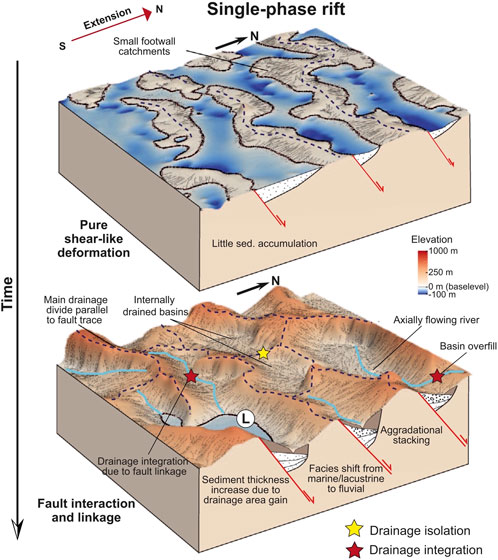Editorial: Links between tectonics, fault evolution and surface processes in extensional systems
- 1GFZ German Research Centre for Geosciences, Potsdam, Germany
- 2Royal Holloway, University of London, Egham, United Kingdom
- 3University of Southampton, Southampton, United Kingdom
- 4University of Leeds, Leeds, United Kingdom
- 5University College London, London, United Kingdom
Editorial on the Research Topic Editorial for:
Links Between Tectonics, Fault Evolution and Surface Processes in Extensional Systems
Extensional tectonic systems are complex and dynamic environments, in which the interplay between tectonic deformation, fault evolution, and surface processes controls basin architecture and sedimentary infill. Assessing the links and interactions between these factors permits an improved understanding of basin evolution and subsequent sediment distribution, with implications for resource exploration and natural hazard assessment. This Research Topic brings together four original research contributions investigating links between extensional tectonics, fault evolution and surface processes, at a range of spatial and temporal scales:
• Veliz-Borel et al. studied upper-plate normal faults along the forearc of the Hellenic Subduction System, which often accommodate fault slip during >Mw 6 earthquakes. Through detailed field mapping and analysis of high-resolution Digital Elevation Models and seabed bathymetry data, the authors assessed active normal faults on and around the islands of Kythira and Antikythira in the Aegean Sea. Faults are found to have accommodated trench-orthogonal (NE-SW) extension during the Quaternary, and fault ruptures as well as increased slip are recorded since the Last Glacial Maximum. Altogether, the data in this study suggests that earthquake clustering in the area may occur over ≤16 ka timescales.
• Sousa et al. present new field observations and novel 40Ar/39Ar geochronology results, which reveal that the Topernawi Formation of the Ekitale Basin, northern Turkana Depression, Kenya was deposited entirely between 29.7 ± 0.5 Ma and 29.24 ± 0.08 Ma (Oligocene), making it the oldest known syn-sedimentary sequence in the area. Furthermore, the authors established a new total sedimentary thickness of 92 m for the Topernawi Formation.
• Lathrop et al. provide a reassessment of fault displacement and length (D/L) scaling laws for normal faults, discuss factors influencing D/L relationships, including both geological factors and measurement errors, and provide a review of previously published D/L databases. The authors present a new Open Access database of >4,000 normal faults that includes detailed information regarding fault length and displacement, lithology of the host rock, the tectonic history of the host basin, and fault maturity, as well as available details on fault evolution over time. The authors found an overall scaling law of D=0.3L0.92 (depending on the factors mentioned above), which can now be used for fault length or displacement predictions, and colleagues are encouraged to use the new fault database presented in this paper for future studies.
• Pechlivanidou et al. investigated topographic evolution, erosion and basin stratigraphy during single and multi-phase rifting by combining numerical methods for simulating tectonic and surface processes (Figure 1). The authors applied a 5 Myr period of extension to numerical experiments with or without topography inherited from a previous rifting phase. The dynamic drainage network evolving in these experiments differed greatly between the single- and multi-phase settings. The qualitative approach presented in this study provides new insights into the impact of extension direction variations on sediment source area distribution and the evolution of syn-rift stratigraphy over time.
Together, these contributions provide novel insights, highlight the importance of studying extension-related processes through a variety of methods, and provide strong incentives for further research efforts in the field of extensional tectonics.

FIGURE 1. Block diagrams illustrating the evolution of topography, drainage network and stratigraphy for a numerical model of single-phase rifting. Modified after Pechlivanidou et al., (2022).
Author contributions
FZ prepared the first draft of the manuscript. All authors contributed to manuscript revision, read, and approved the final version.
Conflict of interest
The authors declare that the research was conducted in the absence of any commercial or financial relationships that could be construed as a potential conflict of interest.
Publisher’s note
All claims expressed in this article are solely those of the authors and do not necessarily represent those of their affiliated organizations, or those of the publisher, the editors and the reviewers. Any product that may be evaluated in this article, or claim that may be made by its manufacturer, is not guaranteed or endorsed by the publisher.
References
Lathrop, B., Jackson, C. A., Bell, R., and Rotevatn, A. (2022). Displacement length scaling relationships for normal faults; a review, critique, and revised compilation. Front. Earth Sci. 10. 1. doi:10.3389/feart.2022.907543
Pechlivanidou, S., Geurts, A. H., Duclaux, G., Gawthorpe, R. L., Pennos, C., and Finch, E. (2022). Contrasting geomorphic and stratigraphic responses to normal fault development during single and multi- phase rifting. Front. Earth Sci. 9, 748276. doi:10.3389/feart.2021.748276
Sousa, F. J., Cox, S. E., Hemming, S. R., Rasbury, E. T., Steponaitis, E., Hatton, K., et al. (2022). New discovery of oligocene strata in the Topernawi Formation, Turkana county, Kenya. Front. Earth Sci. 10, 799097. doi:10.3389/feart.2022.799097
Keywords: rifting, surface processes, fault evolution, volcanism, earthquakes
Citation: Zwaan F, Hughes A, McNeill L, Gregory LC and Faure Walker J (2022) Editorial: Links between tectonics, fault evolution and surface processes in extensional systems. Front. Earth Sci. 10:1054125. doi: 10.3389/feart.2022.1054125
Received: 26 September 2022; Accepted: 05 October 2022;
Published: 25 October 2022.
Edited and reviewed by:
Andrea Billi, National Research Council (CNR), ItalyCopyright © 2022 Zwaan, Hughes, McNeill, Gregory and Faure Walker. This is an open-access article distributed under the terms of the Creative Commons Attribution License (CC BY). The use, distribution or reproduction in other forums is permitted, provided the original author(s) and the copyright owner(s) are credited and that the original publication in this journal is cited, in accordance with accepted academic practice. No use, distribution or reproduction is permitted which does not comply with these terms.
*Correspondence: Frank Zwaan, frank.zwaan@gfz-potsdam.de
 Frank Zwaan
Frank Zwaan Alex Hughes
Alex Hughes Lisa McNeill
Lisa McNeill Laura C. Gregory
Laura C. Gregory Joanna Faure Walker
Joanna Faure Walker